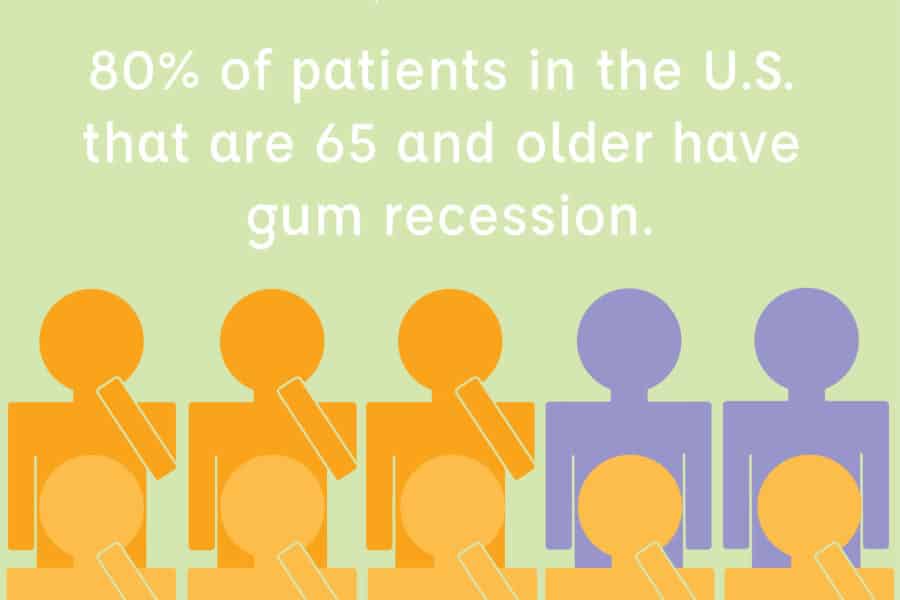Most people think that gum disease means gum infection. But did you know that you might have a form of gum disease called Gum Recession even if you have good home care and pink gums that look healthy?
Gum recession is the pulling away of gums from around your teeth. While recession often occurs due to the gum infection called periodontal disease, it can also occur in a mouth that is free of infection. That means that even if you have great oral hygiene and a great smile, you might still be at risk for gum recession.
Gum recession is a slow process and often occurs without patients realizing it, which is why understanding gum recession and how to treat it is important.
Why are Gums Important?
Gums are soft tissues that cover the jawbone that holds your teeth. Healthy gums form a seal against your teeth to keep them protected. Without a healthy seal, your teeth and gums are vulnerable to disease. Our gums not only support a healthy smile but also an attractive one. Healthy gums offer a shape around our teeth that gives us the best appearance.

But gums also support more than just teeth. They also support your dental work as well. Gums also support our dental work as well. When you dentist places a filling, crown, or partials, our gums are part of their support system.
What Causes Gum Recession?
For many, gum recession is a result of periodontal disease that is caused my harmful bacteria that infects your gums and destroys your gum tissue, thus making them recede. While recession is typically associated with a gum infection, it can also occur in a relatively healthy mouth.
Because gum recession can occur without infection, knowing why healthy gums are at risk is important to your oral health. Gum recession can make your mouth more susceptible to harmful bacteria that can lead to tooth and gum sensitivity in the future. Left untreated, gum recession can also lead to loss of the bone that supports your teeth.
Causes for seemingly healthy gums to recede include:
- Genetics – 30% of patients develop gum recession due to genetic issues. How thick or thin your gums are before recession is determined by genetics and can affect how easily your gums may recede.
- Age – Although recession is most common in patients over 40 years old, it can happen earlier. However, the older you are, the more vulnerable to recession you become. In fact, 80% of patients 65 and older have gum recession.
- Aggressive brushing – Brushing too hard/incorrectly or using anything other than a soft toothbrush or high-quality power toothbrush can cause your gums to recede.
- Abnormal tooth position – Misaligned and missing teeth can affect tooth position in the bone and how your gums seal around them. Misalignment can also affect how your teeth bite together causing trauma to your gums and supporting tissues.
- Grinding or clenching – Even if your teeth align properly, if you grind or clench your teeth, it can cause the supporting tissues to recede due to the extreme pressures.
- Trauma – Although trauma to your gums is often caused by aggressive brushing and biting pressures, injury to your mouth can also lead to recession.
- Oral piercings – Tongue and lip piercings can rub against your gums and cause them to recede.
- Tobacco use – Both smoking and smokeless tobacco can irritate your gum tissue, which leads to recession.
What are the Risks of Gum Recession?
Several negative risks of gum disease include:
- Discolored teeth – As gums recede, the part of the tooth structure that used to be under the gums is exposed. That layer of tooth is called cementum. Cementum is typically more yellow in color compared to your tooth enamel layer, which may make your smile appear discolored.
- Longer appearance of teeth – As gums recede, the shape around your teeth changes and makes them appear longer and less even with other teeth.
- Poor fitting dental work – Dental works such as fillings and crowns will not fit as well when the gum seal changes after they recede. Dental work may appear more noticeable or even darker in color.
- Increased risk of tooth sensitivity – Gum recession causes exposure of cementum, which is a thinner layer of tooth structure and closer to the tooth nerve. Therefore, when it is exposed to cold sources, you feel that cold more intensely and sometimes even painfully.
- Increased risk of tooth decay – Cementum that is exposed because of gum recession is more vulnerable to tooth decay (cavities).
- Increased risk of periodontal disease – Gum recession creates areas that are harder to brush and floss, which may make them more vulnerable to gum disease. Thin gum tissue that no longer seals to your teeth allows harmful bacteria to live under deeper areas in your gums, which can lead to the gum infection called periodontitis. Periodontitis leads to loss of the bone that supports your teeth. Therefore, in severe recession cases, teeth can be lost due to not enough bone to support them.
How Can Gum Disease Be Treated?
Fortunately, procedures called gingival grafts (gum grafts) exist that can help thicken and rebuild lost gums tissue. If you have recession, your dentist may refer you to a periodontist, the dental specialist who will repair your gum recession.
Your periodontist will evaluate your level of recession by measuring not only the length of the recession, but also the attachment and thickness in the area. These measurements determine the best gingival graft for your mouth.
A gingival graft (gum graft) procedure may be recommended. The graft helps to rebuild gum tissue that has been lost. This rebuilding helps to stop recession, protect your teeth and gums, and may even help to prevent future recession.
Typically, gingival grafts (gum grafts) are categorized in three types:
- Free Gingival Graft – This type of graft is done thicken gum tissue that has been thinned. To achieve this, a small layer of gum tissue is removed from the palate (roof of the mouth) and relocated to the area affected by gum recession. This type of graft is less about esthetics (cosmetic appearance) and more about protection of the tissue.
- Connective Tissue Graft – This type of graft is commonly used to cover exposed tooth roots. Tissue is removed from a specific layer of the palate and relocated to the site of gum recession. This type of graft can often reduce the appearance of long or discolored teeth, which can improve cosmetic appearances.
- Allograft (alternative material graft) – This type of graft uses alternative graft material versus using gum tissue from your palate. This means that rather than two sites of the surgery, you only have one, which may reduce discomfort.
Does Having Gum Recession Always Mean Surgery?
Not necessarily. If gum recession is noticed early, it can be stopped and monitored so that no surgery is needed. Your dental professionals will help you identify the causes and will instruct you in how to address it. You may have to re-evaluate your oral hygiene habits like use a soft toothbrush and modify brushing, stop tobacco use, or get a mouth guard.
Knowing how to prevent gum recession is the easiest way to prevent the need for surgery. But rest assured that if you do need surgery, graft techniques involve rather quick recovery with only mild discomfort.
Taking care of your oral health and noticing any changes to your gums is important. Your mouth is a great indicator of your general wellness, and any oral problems can affect your whole body. So, making sure that your gums are not only healthy but also intact and supportive to your teeth is a great way to prevent more serious oral problems in the future.
